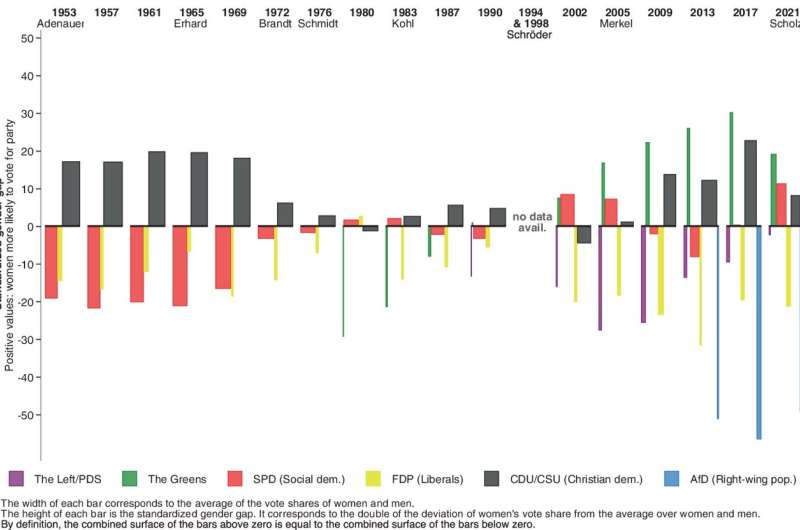This article has been reviewed according to Science X's editorial process and policies. Editors have highlighted the following attributes while ensuring the content's credibility:
fact-checked
trusted source
proofread
In Germany, women vote more left-wing, but that was not always the case

For several years now, women have been voting more left-wing than men. This trend first appeared in the 2017 German general election and intensified in 2021. This has been shown by a study carried out by sociologist Dr. Ansgar Hudde from the Institute of Sociology and Social Psychology at the University of Cologne (UoC).
The trend is most evident among the youngest voters aged 18 to 24. In this group, the Greens, the Left and the Social Democrats (SPD) are much more popular among women than among men; the radical right-wing AfD and, above all, the economically liberal FDP are much more popular among men. The Christian Democrats (CDU/CSU) is the only party with a relatively gender-balanced electorate.
Hudde states, "Since 1953, the gender gap in elections in Germany has never been as large as in 2021 in the 18 to 24 year age bracket." The study "Seven Decades of Gender Differences in German Voting Behavior" was published in the KZfSS Kölner Zeitschrift für Soziologie und Sozialpsychologie (Cologne Journal of Sociology and Social Psychology).
The trend is a reversal of long-term behavior. In the 1950s and 1960s, women inclined to vote more conservatively than men. In the 1970s and 1980s, gender differences were small. Since the 2000s, gender differences in voting behavior have been increasing. However, the preferences of women and men in their voting decisions initially did not follow a clear left-right political divide. For example, the Greens and the Left are both in the left-wing part of the party constellation, but the Greens were initially much more popular with women than with men, while the Left was the other way around. It was only since the 2017 Bundestag election (German general election) that women have increasingly been voting for the left compared to men.
Hudde used a unique data source for his research—information about the actual voting behavior of voters from real ballots since 1953. In some polling stations selected by the Federal Returning Officer, the ballot papers collect information on the gender and age group of voters. In the 2021 Bundestag election, about 1.9 of the 61.2 million ballot papers contained such age and gender markings.
The ballot papers are then sorted separately by gender and age groups and the results are published by the Federal Returning Officer in the "Representative electoral statistics." This information describes the actual voting behavior much better than, for example, opinion polls. "The data does not measure what people say, but what they actually do," says the UoC sociologist.
The voting behavior by gender in the last Bundestag election was as follows: The AfD received more votes by men (13.0% vs. 7.8% of women). However, the gender gap goes far beyond the AfD. This is particularly evident for the youngest age group. Young men voted for the FDP most frequently in 2021 (26.2% vs. 14.8% of women) and young women most often for the Greens (28.3% vs. 19.7% of men). In this age group, the Left and SPD are also much more popular among women than among men; the AfD, on the other hand, is much more popular among men. The CDU/CSU is the only party with a relatively gender-equal electorate among young adults.
In general, the Greens had the most male-leaning electorate in the early stages of the party in the 1980s, but since the '00s, the party has been much more popular with women than with men. The Left also had a strongly male-dominated electorate. In the last Bundestag election, however, the party was almost equally popular among women and men. In the youngest age group, the Left is much more female-leaning even. CDU/CSU lost its lead among women in the last Bundestag election, and the SPD was able to become more successful with women in particular.
According to Hudde, the party-political gender gap has consequences. Growing gender-specific differences in voting behavior could lead to gender equity becoming once again a field of conflict. "If gender increasingly becomes a political divide, it means that the dividing line runs through many families, circles of friends and couples," the sociologist says.
"This can lead to an increasing number of couples, groups of friends and families in which members are politically divided. This can bring political conflict to the dinner table." But this political division can also be constructive, the researcher hypothesizes. Social and political issues of conflict could be discussed in a safe space, which can promote mutual understanding across political divides and thus contribute to social cohesion.
More information: Ansgar Hudde, Seven Decades of Gender Differences in German Voting Behavior, KZfSS Kölner Zeitschrift für Soziologie und Sozialpsychologie (2023). DOI: 10.1007/s11577-023-00904-4
Provided by University of Cologne



















